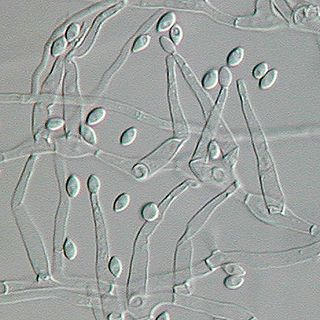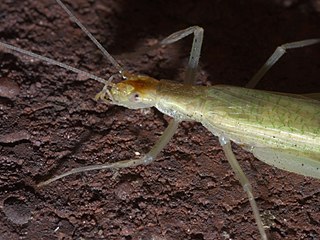
The Eurotiales are an order of sac fungi, also known as the green and blue molds. It was circumscribed in 1980.

Rubus niveus is a species of Rubus. The native range of this scrambling shrub stretches from Afghanistan to central China, down to Java and Indo-China. It grows primarily in temperate regions.

Paecilomyces is a genus of fungi. A number of species in this genus are plant pathogens.
Neoflavonoids are a class of polyphenolic compounds. While flavonoids have the 2-phenylchromen-4-one backbone, neoflavonoids have the 4-phenylchromen backbone with no hydroxyl group substitution at position 2.
Paecilomyces fulvus is a plant pathogen that causes Byssochlamys rot on strawberries.
Helianthus niveus is a species of sunflower known by the common names showy sunflower and snowy sunflower. It is native to northern Mexico and the Southwestern United States.
Malacothamnus jonesii is a species of flowering plant in the mallow family which has three varieties, two of which are sometimes recognized at the species rank as Malacothamnus gracilis and Malacothamnus niveus. Malacothamnus jonesii is endemic to San Luis Obispo County, California and just over its northern and southern borders in Monterey and Santa Barbara counties.

Echinops niveus is a species in the genus Echinops or globe thistles. It is native to the Indian subcontinent: Himachal Pradesh, Jammu and Kashmir, Uttar Pradesh, Nepal.

Pterophorus niveus is a moth of the family Pterophoridae. It is found from Indonesia to the Solomon Islands and north to Luzon.

Farinomalein is a natural maleimide with formula C10H13NO4 - was first isolated from the entomopathogenic fungus Isaria farinosa (Paecilomyces farinosus) - source H599 (Japan).
Byssochlamys is a former genus of fungi in the Trichocomaceae family, containing teleomorph forms of Paecilomyces. Several species of the genus Byssochlamys were well known to be associated with food spoilage, especially acidic heat-processed foods. A health concern was the production the mycotoxin patulin in fruit juices, as well as byssochlamic acid and mycophenolic acid.

Purpureocillium is a fungal genus in the Ophiocordycipitaceae family. The genus now contains at least 5 species with the type species Purpureocillium lilacinum, a common soil mold. It has been isolated from a wide range of habitats, including cultivated and uncultivated soils, forests, grassland, deserts, estuarine sediments and sewage sludge, and insects. It has also been found in nematode eggs, and occasionally from females of root-knot and cyst nematodes. In addition, it has frequently been detected in the rhizosphere of many crops. The species can grow at a wide range of temperatures – from 8 to 38 °C for a few isolates, with optimal growth in the range 26 to 30 °C. It also has a wide pH tolerance and can grow on a variety of substrates. P. lilacinum has shown promising results for use as a biocontrol agent to control the growth of destructive root-knot nematodes.

Purpureocillium lilacinum is a species of filamentous fungus in the family Ophiocordycipitaceae. It has been isolated from a wide range of habitats, including cultivated and uncultivated soils, forests, grassland, deserts, estuarine sediments and sewage sludge, and insects. It has also been found in nematode eggs, and occasionally from females of root-knot and cyst nematodes. In addition, it has frequently been detected in the rhizosphere of many crops. The species can grow at a wide range of temperatures – from 8 to 38 °C for a few isolates, with optimal growth in the range 26 to 30 °C. It also has a wide pH tolerance and can grow on a variety of substrates. P. lilacinum has shown promising results for use as a biocontrol agent to control the growth of destructive root-knot nematodes.
Rhodotorulapepsin is an enzyme. This enzyme catalyses the following chemical reaction

Paecilomyces variotii, also known by the name Byssochlamys spectabilis for the sexual state, is a common environmental mold from the Phylum Ascomycota. It is widespread in the environment and can be found in composts, soils and wood, as well es a common environmental contaminant in indoor air and carpet dust. Ascospores of the sexual state of P. variotii are strongly heat-resistant. As such the fungus is a common contaminant of heat-treated foods and juices. Paecilomyces variotii has been associated with a number of infective diseases of humans and animals.
Isaria fumosorosea is an entomopathogenic fungus, formerly known as Paecilomyces fumosoroseus. It shows promise as a biological pesticide with an extensive host range.
Paecilomyces marquandii is a soil-borne filamentous fungus distributed throughout temperate to tropical latitudes worldwide including forest, grassland, sewage sludge and strongly metal polluted area characterized by high tolerance in heavy metals. Simultaneous toxic action of zinc and alachlor result an increase in uptake of metal in this fungus but disrupts the cell membrane. Paecilomyces marquandii is known to parasitize the mushroom, Cuphophyllus virgineus, in the family, Hygrophoraceae. Paecilomyces marquandii is categorised as a biosafety risk group 1 in Canada and is not thought to be a significant pathogen of humans or animals.

Oecanthus niveus, known generally as the narrow-winged tree cricket or snowy tree cricket, is a species of tree cricket in the family Gryllidae, which includes all crickets. First noted by Swedish Entomologist Charles de Geer in 1773 by a Pennsylvanian Specimen, it is found primarily in Eastern North America south of Canada, and also in the Caribbean.

Mariannaea elegans an anamorphic fungus. It is mainly found on rotting wood and soil. M. elegans is not pathogenic to humans, animals, or plants.
Paecilomyces dactylethromorphus is a species of fungus in the genus Paecilomyces in the order of Eurotiales.









